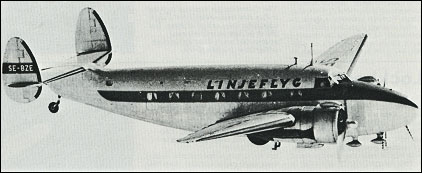|
| Design and development of the Lockheed 18 Lodestar began as a result of the poor sales achievement of the Lockheed 14 Super Electra, the prototype being flown for the first time on 21 September 1939. Converted from a Super Electra, it differed primarily by having the fuselage lengthened by 1.68m to provide accommodation for 15 to 18 passengers, depending upon the other facilities provided; some were produced with high-density bench seating for a maximum of 26 passengers, and were available with a variety of engines by Pratt & Whitney and Wright. Despite the improved economy demonstrated by the Lodestar, Lockheed failed again to achieve worthwhile sales in the United States as most operators were committed to purchase DC-3s from the Douglas Company. Fortunately, the type appealed more to export customers, with airlines or government agencies in Africa, Brazil, Canada, France, the Netherlands, Norway, South Africa, the UK and Venezuela ordering a total of 96 aircraft. There was only limited military interest before the beginning of World War II, but later procurement, particularly by the US Army Air Force, raised the total of Lodestars built by Lockheed to 625 before production ended. Unlike the Hudson, the Lodestar has no record of stirring action but, nevertheless, the type was able to fulfil an important medium-range transport role. Only small numbers saw post-war service, mostly with small operators, but a number of interesting conversions as executive transports were carried out in the USA by companies like Howard Aero and Lear Inc.

| MODEL | Lockheed Lodestar Model 18-07 |
| ENGINE | 2 x Pratt & Whitney Hornet S1E2-G radial piston engines, 652kW |
| WEIGHTS |
| Take-off weight | 8709 kg | 19200 lb |
| Empty weight | 5103 kg | 11250 lb |
| DIMENSIONS |
| Wingspan | 19.96 m | 66 ft 6 in |
| Length | 15.19 m | 50 ft 10 in |
| Height | 3.61 m | 12 ft 10 in |
| Wing area | 51.19 m2 | 551.00 sq ft |
| PERFORMANCE |
| Max. speed | 351 km/h | 218 mph |
| Ceiling | 6220 m | 20400 ft |
| Range | 2897 km | 1800 miles |
 | A three-view drawing (800 x 368) |
| Dan Colburn, e-mail, 07.11.2010 05:36 I flew Lodestar for the Rock Island Lumber Co.The Weyerhaeuser family from 1956 to 1962 company. Our Lodestar was a Navy R3D had Wright 1820 engines.
Our license number was N4S for "Four Square" lumber. I flew it 2500 hours without an engine failure. This was due to our wonderful maintenance man Mr. Bob Sanders. I don't remember ever canceling or delaying a flight due to mechanical problems. reply | | Harold Carlin, e-mail, 08.09.2010 04:55 Flew as radioman on this plane out of Naval Air Station at Corpua Christie,Texas. Admiral Mason was in charge of all primary pilot training and traveled to Pensacola,Jacksonville,&Washington DC .This was in 1943 & 1944 reply | | Harold Carlin, e-mail, 08.09.2010 04:48 Flew as radioman on this plane out of Naval Air station, Corpus Christ, Tex.Admiral Mason was in charge of all primary pilot training & used to fly to Pensacola, Jacksonville & Washington,DC in 1943&194 reply | | JERRY THOMPSON, e-mail, 19.01.2010 02:05 I flew a Ventura, (PV-1) in early 60's. It was a larger version of the Lodestar, and was remanufactured and modified by the DEE HOWARD company of San Antonio,Tx. It was the ultimate airplane of the piston engine era. Two R-2800-10 2000 H.P. engines, wing and fuselage changes. DC-6 landing gear and props gave it a cruising speed of 312m.p.h. at 57% power at 10000 ft. Ed Sweringen was the excelent design engineer for howard. reply | |
| | Gerald Barnes, e-mail, 07.09.2010 23:39 International Paper Company had a fine plain Lodestar with Wright 1820s, N59720. I co-piloted her from 1970-1972 out of Mobile, Alabama. She had been ordered by IP and was conscripted during WWII before they took possession. After the war, IP took the bird out of the box and used it until at least the mid '70s then gave it to a university up north. Great old bird, tough and resilient. reply |
| sid glaser, e-mail, 14.07.2009 16:18 I flew from Managua, Nicaragua to Miami on a TACA Airlines Lodestar in March, 1944. we left MGA at 7 AM and after stops in Tegucigalpa, San Salvador, and Merida, Mexico, we landed in MIA in late afternoon.
It was my second airplane ride after arriving in MGA in a TACA Tri-Motor Ford.
Of my more than 700 commercial flights, those two are still the most memorable. reply | | Joe, e-mail, 20.02.2009 04:39 I flew N1490V for six years from 1962. 1490V had the Wright Cyclone R-1820-56 engines. A straight Vanilla lockheed. The only Mod was the longer tail cone. Reliable machine . Had the L-2 auto pilot and a RDR Bendix Radar. The interior had a Couch and Bar, Card Tables and opposing seats.
Joe Moore reply | | Jack Thompson, e-mail, 14.05.2008 02:50 Grand Old BIRD......Enjoyed flying it for many years. I really loved it......Sorry theres mot many left and you don't hear too much about them.............Jack Thompson reply |
|
Do you have any comments?
|
| 
COMPANY
PROFILE
All the World's Rotorcraft
|




 Bob
Bob Gerald Barnes
Gerald Barnes Gerald Barnes
Gerald Barnes




Did you know Leonard McGee who also flew with IP in Mobile?
reply